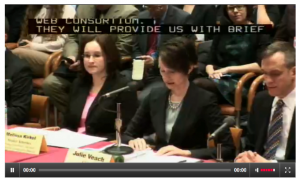For the first time, the government will require that every citizen purchase health insurance or obtain it from another source, such as an employer.
Recognizing that lower income families won’t be able to afford policies on their own, subsidies will be available starting in 2014 to people with annual incomes between 133 percent and 400 percent of the federal poverty level. (In 2011, that upper threshold represented a yearly income of $43,560 per year for one person and $89,400 for a family of four.)
The government will seek to enforce this insurance mandate by fining people who elect not to purchase coverage. People will pay the higher of two penalties: flat fees beginning at $95 per person in 2014 and climbing to $695 in 2016, or fines consisting of 1 percent of taxable income in 2014 and 2.5 percent in 2016.
People who previously were uninsured and who don’t qualify for Medicaid will have the opportunity to purchase coverage on insurance “exchanges” including one currently being planned in Illinois.
Think of a health insurance mall, with standardized policies offered by different companies and a requirement that coverage be offered to everyone, regardless of pre-existing medical conditions. Up to 300,000 Illinoisans are expected to purchase coverage through the state’s exchange, according to a report from the Illinois Health Care Reform Implementation Council.
“They want to make us buy insurance? I feel it’s too much. We won’t be able to afford it. It’s too high,” said Marian Caruthers, 53, of Calumet City, who drives a van for a private company that doesn’t offer medical coverage.
A diabetic, Caruthers had arranged recently to go to CommunityHealth’s clinic in Englewood so a doctor could check on a nasty, persistent cough. Before learning about CommunityHealth a year ago, Caruthers said she’d gone “a long time without seeing a physician, probably about five years.”
“With all the people who are out of work, why would they ask us to spend money on something like this?” Caruthers wondered.
There’s a good answer to that question: with health insurance, low income workers in fast food restaurants, nursing homes, factories and have a better chance of staying healthy and perhaps achieving their aspiration of entering the middle class, said John Bouman, president of the Sargent Shriver National Center on Poverty Law in Chicago. “Without insurance people are more easily distracted by illness and medical bills and they have a more fragile base for staying in the workforce,” he said.
Connecting people with “medical homes” in their communities is another key objective of health reform, despite concerns about medical manpower. Currently, many people in disadvantaged communities don’t have ongoing relationships with primary care doctors and use emergency rooms for basic care – an expensive, inefficient way of receiving medical services.
The health care overhaul addresses the problem by providing more money for primary care and by encouraging medical providers to join together in “accountable care organizations” that assume responsibility for providing cost-effective, high quality medical services.
Illinois’ Medicaid program is moving in the same direction: under legislation passed in January, it’s committed to shifting half of the state’s 2.8 million Medicaid members to managed care or “integrated care” plans that will focus on establishing medical homes for these needy men, women and children.
On the South and West sides, several notable experiments aimed at restructuring medical services are underway. With Medical Home Network, hospitals and clinics have agreed to work more closely together to bolster basic care for Medicaid members and pay closer attention to patients who return home after a hospital stay. The South Side Healthcare Collaborative – a network of more than 30 health clinics and five hospitals – is similarly devoted to establishing “medical homes” for residents.
“For the first time, we are thinking in a systemic way about how we can improve healthcare quality and access,” said Dr. Eric Whitaker, executive vice president of strategic affiliations at the University of Chicago Medical Center, a founding member of the South Side initiative.
To be successful, efforts like these will have to deliver services “in an environment that is culturally and linguistically sensitive” to Latinos, African Americans and various ethnic groups that live on the South and West sides, said Judith Haasis, CommunityHealth’s executive director.
From a patient’s perspective, the new initiatives may mean interacting with new types of medical personnel such as care coordinators, patient navigators and health educators and being encouraged to seek care more regularly, to keep medical problems from worsening or developing in the first place.
That makes sense to Philip Thompson of the South Side, who’s uninsured and unemployed. Thompson had travelled to the Fantus Clinic on a recent afternoon complaining of back pain and seeking narcotics. “You cut back on your health in the name of saving a buck and it’ll cost you two bucks on the other end,” said this lanky, 64-year-old, who acknowledged that he doesn’t “have a clue” about health reform.
Undocumented immigrants will not be eligible for Medicaid under health reform. That will leave a sizeable number of people in the state – between 300,000 and 600,000, according to a report from the Illinois Health Care Reform Implementation Council – still without any type of medical coverage.
The Cook County Health System and other safety net medical providers will struggle to redefine themselves as the ranks of the uninsured diminish and those who remain without coverage are in the country illegally.
In this group will be Talina Morales, 30, whose family crossed the border illegally from Mexico years ago and ended up living in Chicago. A year and a half ago, Morales’ father had his left leg amputated because of poorly managed diabetes; her mother, who’s obese and who works in a flea market on weekends, can barely get around. Morales started going to CommunityHealth for counseling after her brother was murdered earlier this year.
“It’s all a pile of lies; I don’t really care about politics,” said Morales, when told about the health care overhaul. She expects her family to continue going without needed medical care most of the time, despite services available at CommunityHealth and the Cook County Health System.
On the South Side, the future of Cook County’s Provident Hospital has been up in the air for years. Whitaker of the University of Chicago said he worried about that institution closing, saying that “it is a huge resource and health care reform could be a powerful impetus to breathe new life in it.” Discussions between the County and the University of Chicago over Provident’s future have faltered but have started again, with the arrival of a new chief executive at the county health system. “It seems there may be some interest in moving forward,” Whitaker said.
A Sampling of Other Health Reform Provisions that Will Affect Consumers:
- Young adults can stay on their parents insurance plans up to the age of 26.
- Insurers can’t sell new policies excluding children with pre-existing conditions.
- Insurance coverage will be guaranteed to anyone with a pre-existing condition in 2014.
- Seniors will have access to a much broader range of preventive services at no extra cost.
- Fewer seniors will fall into the “donut hole” – a coverage gap – when paying for prescription drugs. The donut hole is being phased out by 2020 and seniors’ share of drug costs will diminish.
Judith Graham has covered health policy for dozens of years. For many years, she was a health and medicine correspondent at the Chicago Tribune. Her work has appeared in the Washington Post, Los Angeles Times, Baltimore Sun, Philadelphia Inquirer, Seattle Times and the New York Times, among other publications.
For our “Waiting for Health Care Reform” video, click here – for a slideshow, click here. For all our health-care videos in HD, visit IHM’s new Vimeo channel.













Be First to Comment